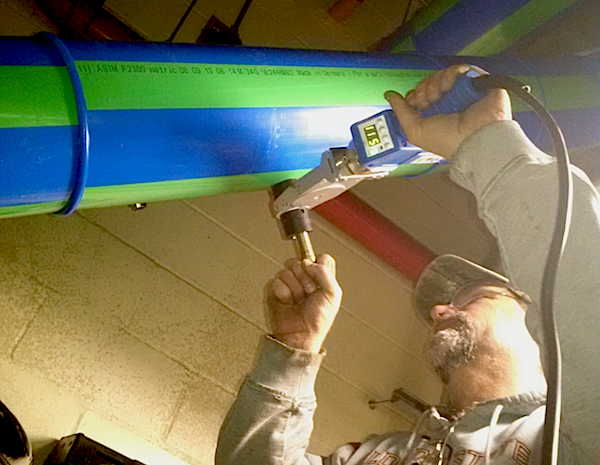 There’s nothing more catastrophic for a business than a major data loss. Natural disasters, computer viruses and even basic equipment malfunctions can cost millions in data disaster recovery, redevelopment and user notification. And if a company suffers a breach of customers’ personal information, it could be open to a lawsuit.
There’s nothing more catastrophic for a business than a major data loss. Natural disasters, computer viruses and even basic equipment malfunctions can cost millions in data disaster recovery, redevelopment and user notification. And if a company suffers a breach of customers’ personal information, it could be open to a lawsuit.
Of course, the best way to mitigate these fiascos is through prevention. In February 2014, CxP Data centers in Jacksonville, FL, opened a state-of-the-art 120,000-sq-ft retrofitted co-location center to provide dependable, reliable security for any organization’s most valuable information 24 hours a day, seven days a week, and 365 days a year.
Among myriad other services, such as data recovery, business-continuity planning and cloud computing, CxP’s physical colocation solutions require a great deal of space, power and cooling to house, store, and protect any firm’s most precious asset.
To create a windowless 18,000-sq-ft data bunker, CxP assembled cold-aisle containment systems, a Siemens Apogee Control System building automation system and advanced fire-suppression systems. The data center features 4.5 mw of total power; 3.5 mw of critical power; dual diversified power feeds from separate substations; true A and B power to each rack, cage or suite; and fully automated redundancy. Keeping the equipment secure are cutting-edge IP camera systems, two-factor badge and biometric access-control systems, granular cage and rack badge and biometric options as well as a year-round security staff.
To help keep all of its powerful equipment cool, CxP needed a chilled-water piping system that was just as safe and secure as its systems.
“If the servers get hot, they go down, and that’s bad news for the client. So, it’s extremely important that, one, the room stays cool, and, two, there are no leaks,” said Glen Drummond Jr., product manager of the Jacksonville branch for Ferguson Enterprises. Ferguson is a wholesale distributor with 1,350 locations and serves customers throughout the United States, Puerto Rico, the Caribbean, and Mexico, and the manufacturer’s representative for Aquatherm in Florida and other areas of the country.
PP-R Piping Produces Quick Results
Although the 1983 building’s existing steel piping system was demolished, the engineer also had specified steel for the new chilled-water piping system. However, CxP needed the system to be functional in only four-and-a-half weeks. Fabricating a steel piping system in such a short time frame would have been impossible.
“There was a lot of pipe to put together in a short amount of time,” said Marc Hirst, project manager for The Haskell Company, a design-build (D-B) firm with headquarters in Jacksonville. The company has several offices throughout North America and is a leader-integrated D-B firm in the industrial, commercial, government and civil infrastructure markets.
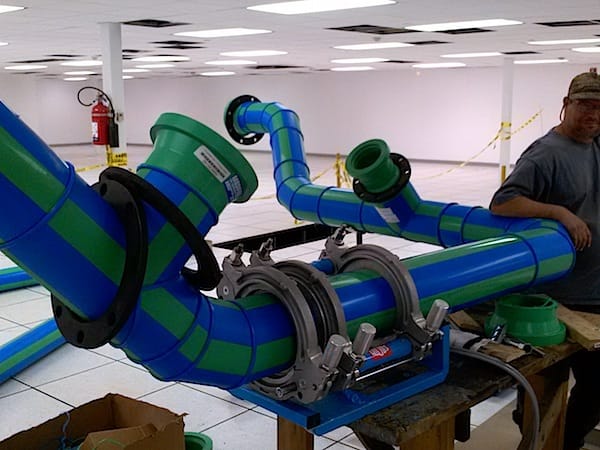
“With steel, we would have been working two shifts, 24 hours a day,” Hirst said. “We were really trying to step it up for the client because the timing was critical to their survival. It gives you even more motivation.”
Construction manager for CxP’s three-phase project, Rich Jordan of DSA Encore, an East Coast boutique D-B, equipment, and service organization that focuses solely on data centers, suggested Aquatherm polypropylene-random (PP-R) piping systems as a quicker, leak-free solution.
John S. Fortenberry, P.E., LEED AP BD+C, a senior mechanical engineer with Haskell, had first learned about Aquatherm via a lunch-and-learn session, and he saw the potential for significant labor and time savings using PP-R. According to Drummond, a welder can join a 6-in. steel pipe in an hour and 15 minutes while Aquatherm’s heat-fusion welding process requires only three minutes, 24 seconds for heating and 7 minutes for cooling before the welder can move to the next joint.
Aquatherm piping uses quick and easy heat fusion to form connections; this process bonds both sides of a joint into a single, homogenous material without the use of chemicals or mechanical connections, which eliminates systematic weaknesses and fail-points in the pipe. The seamless heat-fusion connections, combined with the piping’s resistance to corrosion and abrasion, help ease leakage concerns. And the company backs its product with an unrivaled 10-year, multimillion dollar warranty through Zurich Insurance that covers parts, labor, incidental damages, and loss of use of the facility in case of failure due to manufacturer defect.
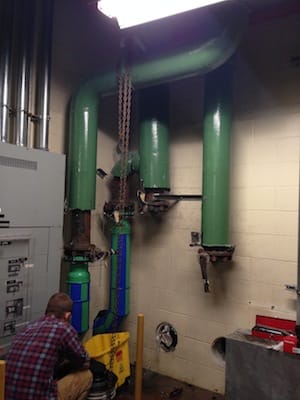
“Aquatherm’s time to install is a lot less than steel,” said Jim Ferguson, technology consultant for CxP. “And I like not having to rely on arc welders.”
“You can have guys doing in a few minutes what would take them a few hours to do with steel,” Hirst said.
By choosing Aquatherm, CxP also was able to save time simply because PP-R piping is so much lighter than steel. An 8-in. steel pipe weighs 29 lb per foot while 8-in. Aquatherm pipe weighs 4 lb per foot. “You can just imagine the JAX Refrigeration team having to carry that around all day,” Drummond said.
Additionally, dealing with heavy pipe can create safety issues. “I really love the safety aspect of Aquatherm,” Hirst said. “The pipe weighs virtually nothing. If you drop it, it’s not going to hurt anybody.”
Using steel pipe on the project “would have been really dangerous,” Hirst said.
Heat Fusion Allows Indoor Installation
To build CxP’s chilled-water system, Jacksonville mechanical contractor JAX Refrigeration used approximately 1,200 ft of Aquatherm Blue Pipe® in 8-, 6-, 4-, 3-, 2- and 1½-in. sizes. JAX started in the mechanical room with the 8-in. pipe, punched through a firewall and connected to about 800 ft of 6-in. pipe, which was run under the floor.
The 6-in. pipe was connected to 4-in. pipe at the Liebert 75-ton chilled water units; 3-in. pipe was run from the units and joined with 4-in. pipe that was connected to 6-in. pipe under the floor. The pipe then was run back through the firewall using Walraven BIS Pacifyre AWM III Fire Collars and joined with the 8-in. pipe, which was connected to the chiller.
Additionally, the Aquatherm piping system only needed ½-in.-thick insulation rather than the 2-in.-thick foam-glass insulation that would have been required for steel pipe.
Long-lasting Aquatherm Blue Pipe was selected as it is specifically engineered for heating and cooling, industrial, geothermal and compressed-air applications. All of Aquatherm’s PP-R piping systems are made of a simple, chemically stable thermoplastic that is non-corroding, so it won’t wear out, weaken, or clog after a few years. The material won’t react with water or most dissolved chemicals, so it won’t scale or erode—problems that cause the majority of long-term piping failures.
Because Aquatherm’s heat fusion connections do not require flames or produce fumes or gases, two installers were able to put the system together with Widos equipment leased from Ferguson and immediately make any required adjustments onsite as they worked; joining steel—with its open flames and odorous fumes—would have meant working outside in the parking lot.
In this first phase of the project, “we were working in an existing building with existing smoke detectors and fire equipment,” Hirst said. “With steel pipe, I would have had to have the guys working outside. [With Aquatherm], we did not have to deal with the challenges of welding steel pipe in confined spaces and maintaining the necessary safeguards required for such tasks.”
Reliable Piping System Surprises Installers
To test for leaks, the JAX Refrigeration left 100 psi of compressed air in the piping system for nine days. During the test period, the temperature fluctuated from a typical Florida winter average of 70˚F to a sudden 20˚, 12˚ with the wind chill. When the temperature drops, air loss is anticipated; a copper piping system, for example, would have lost 20-30 psi of air pressure.
“You expect at least some leaks—you expect to have to go back and change something,” Drummond said. But even with 500 individual joints, “there were zero leaks. The Aquatherm system didn’t lose any air.”
Hirst noted even the installers were impressed.
“I actually asked the installers, ‘If you had to work with one material forever on every project, would you rather work with steel or Aquatherm?’ And they all said Aquatherm,” he said. “It’s one thing if everybody loves working with it, but that means nothing if there are a bunch of leaks. But we didn’t fail any of our pressure tests. Everything passed right away.”
Haskell, DSA Encore and JAX Refrigeration were able to complete the project on an incredibly tight deadline. Fortenberry estimated that while it took roughly four weeks to install Aquatherm, it would have been twice that using steel. While his Haskell colleague Hirst reported that using Aquatherm resulted in an overall cost savings of roughly 10-15%.
Haskell founder and chairman, Preston Haskell, P.E., visited the jobsite during the mechanical installation. He was impressed with the lighter weight of Aquatherm and the ease of handling, cutting, splicing and installing fittings associated with it.
“I was surprised by how quickly and easily the pipe and fittings could be joined without using an open flame and the hazard that accompanies it,” he said. “It was also impressive how easy it was for them to put in tees or other fittings for future alterations or expansion, and when you combine that with its superior thermal value—it was a benefit and provided a cost advantage,” Haskell added.
The Aquatherm installation began the first week of December 2013 and was completed almost exactly a month later. CxP already is planning on using Aquatherm piping systems in Phase 2 of the project. Jim Ferguson reported that he looks forward to using Aquatherm piping again. “I had no problems on [Phase 1 of] the project. Zero,” he said. “Aquatherm is just a great product.”
And according to Drummond, DSA Encore was so pleased with the results that the company wants to standardize Aquatherm products for all chilled-water and fire-protection piping systems in all of its future data center projects.
“They want to set themselves apart,” Drummond said.

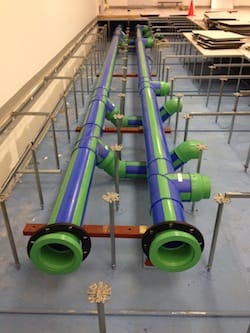
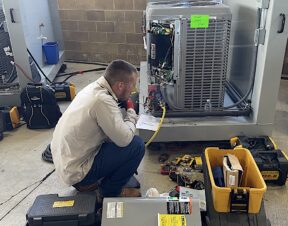


Join the conversation: